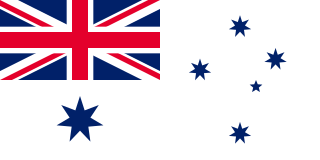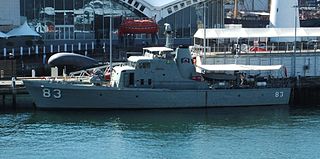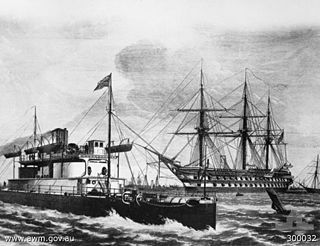
The Royal Australian Navy (RAN) is the naval branch of the Australian Defence Force (ADF). The professional head of the RAN is Chief of Navy (CN) Vice Admiral Mark Hammond. The Chief of Navy is also jointly responsible to the Minister for Defence (MINDEF) and the Chief of the Defence Force (CDF). The Department of Defence, which is a part of the Australian Public Service, administers the ADF, and ergo, the Royal Australian Navy. In 2023, the Surface Fleet Review was introduced to outline the future of the Navy.

HMQS Gayundah was a flat-iron gunboat operated by the Queensland Maritime Defence Force and later the Royal Australian Navy. She entered service in 1884 and was decommissioned and sold to a civilian company in 1921. She then served as sand and gravel barge in Brisbane until the 1950s, when she was scrapped. In 1958, Gayundah was run aground at Woody Point near Redcliffe, to serve as a breakwater structure.

HMVS Cerberus is a breastwork monitor that served in the Victoria Naval Forces, the Commonwealth Naval Forces (CNF), and the Royal Australian Navy (RAN) between 1871 and 1924.

HMAS Aitape was an Attack-class patrol boat of the Royal Australian Navy (RAN). It was named for the small town of Aitape, Sandaun Province, Papua New Guinea. Completed in 1967, the vessel was one of five assigned to the RAN's Papua New Guinea (PNG) Division. The patrol boat was transferred to the Papua New Guinea Defence Force in 1974 as HMPNGS Aitape. She remained active until 1982, when she was removed from service for use as a parts hulk. Aitape was scuttled off Port Moresby for use as a dive wreck in 1995.

HMAS Ardent was an Attack-class patrol boat of the Royal Australian Navy (RAN). She was built by Evans Deakin and Company, and was commissioned into the RAN in 1968. Ardent was decommissioned in 1994, then assigned as a navigation training vessel. At the end of 1998, she was removed from service. Initially marked for preservation at the Darwin Military Museum, the vessel was sold into civilian service in 2001 after the Northern Territory government declined. In 2002, the patrol boat was acquired by the Indonesian Navy, and commissioned as KRI Tenggiri (865) in 2003.

HMAS Attack was the lead ship of the Attack-class patrol boats used by the Royal Australian Navy (RAN). Launched in April 1967 and commissioned in November that year, the ship was largely commercial in design and was used to protect fisheries in Australia's northern waters, and to support the survey ship Moresby. The vessel remained in RAN service until 1985 when it was transferred to the Indonesian Navy and renamed Sikuda.

HMAS Madang, named for the settlement of Madang in New Guinea, was an Attack-class patrol boat of the Royal Australian Navy (RAN). Completed in 1968, the vessel was one of five assigned to the RAN's Papua New Guinea (PNG) Division. The patrol boat was transferred to the Papua New Guinea Defence Force in 1974 as HMPNGS Madang. She was decommissioned in 1989.

HMAS Samarai, named after the island of Samarai and its former town, was an Attack-class patrol boat of the Royal Australian Navy (RAN). Completed in 1968, the vessel was one of five assigned to the RAN's Papua New Guinea (PNG) Division. The patrol boat was transferred to the Papua New Guinea Defence Force in 1974 as HMPNGS Samarai. She remained in service until 1987, when she was paid off and used as a parts hulk.

Before Federation in 1901 five of the six separate colonies maintained their own naval forces for defence. The colonial navies were supported by the ships of the Royal Navy's Australian Station which was established in 1859. The separate colonies maintained control over their respective navies until 1 March 1901, when the Commonwealth Naval Forces was created.

HMQS Paluma was a flat-iron gunboat operated by the Queensland Maritime Defence Force and later the Royal Australian Navy. She entered service on 28 October 1884, was decommissioned in 1916 and then sold to the Victorian Ports and Harbours Department, who operated her under the name Rip until 1948 when she was retired. She was scrapped in 1950–51.

HMQS Mosquito was a torpedo boat operated by the Queensland Maritime Defence Force and Commonwealth Naval Forces. She entered service in 1885 and after Federation was transferred to the Commonwealth Naval Forces, serving as a training vessel until she was paid off in 1910.

After the formation of the Queensland Maritime Defence Force in 1884, the colonial government purchased two gunboats and a torpedo boat to equip the new force. However, given the number of ports along the Queensland coast, it was realised that additional ships were required. Five ships had already been ordered for the Queensland Department of Harbours and Rivers when the decision was taken to convert them to also serve as auxiliary gunboats. This resulted in the fitting of a 5-inch gun and the relocation of the boilers below the waterline. The ships were as follows: Bonito, Bream, Dolphin, Pumba, and Stingaree.

HMAS Diamantina (K377/F377/A266/GOR266), named after the Diamantina River in Queensland, is a River-class frigate that served the Royal Australian Navy (RAN). Constructed in the mid-1940s, Diamantina was active from 1945 until 1946, was placed in reserve, then was recommissioned as a survey ship from 1959 until 1980.

HMCSProtector was a large flat-iron gunboat commissioned and purchased by the South Australian government in 1884, for the purpose of defending the local coastline against possible attacks in the aftermath of the 'Russian scare', of the 1870s. She arrived in Adelaide in September 1884 and served in the Boxer Rebellion, World War I and World War II.

HMQS Midge was a torpedo launch that served with the Queensland Maritime Defence Force, the Commonwealth Naval Forces and the Royal Australian Navy. After entering service in 1887, Midge served as "picquet boat" along the Brisbane River until Federation in 1901, when she was transferred to the Commonwealth. After this, she served as a training boat until 1912 when she was decommissioned.

HMQS Miner was a vessel built for the Queensland Army before being transferred to the Queensland Maritime Defence Force. She was not taken on strength by the Commonwealth Naval Forces at Federation in 1901 and subsequently sold.
HMVS Albert was a gunboat of the Victorian Naval Forces which was requisitioned for service with the Royal Australian Navy during World War I.
Twelve ships of the Royal Navy have been named HMS Otter, for the otter.
Several ships have been named Otter for the marine mammal otter:














